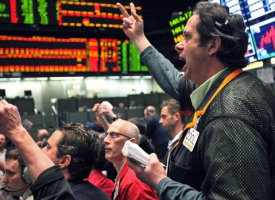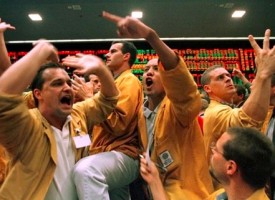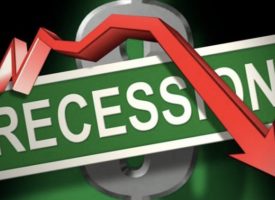With crude oil falling 2.5 percent, today two legends in the business sent King World News powerful pieces exposing new signs of liquidity stress, a major warning and a surprise in China.
“E. George Schaefer, a Dow Theorist, termed and referred to the D-J Industrial Average’s 200-day moving average as ‘The Investment Line’.” — The Traders’ Club
November 11 (King World News) – Charles Dow and Edward Jones established the Dow Jones indices (Industrials and Transports) in the late 1880s. Charles Dow went on to proffer Dow Theory, which is based on the relationship of those two indices. Dow believed the two averages must confirm each other on the upside, and the downside, and that the volume must also confirm the direction of the market’s move. Above all, he thought that “price” discounts everything because “price” has already factored in all the fundamental data.
When Charles Dow died in 1902, another Dow Theorist expanded on his work. William P. Hamilton was the one who championed Dow’s work after his death and who opined that Dow Theory is not infallible. Next was Robert Rhea, who used Dow Theory successfully to buy and hold stocks from 1921 until 1928. While he missed the final upside blow-off move into the 1929 peak, he did manage to play the “short-side” profitably into the early 1930s.
More importantly, Rhea called the bottom in the stock market in July of 1932, as well as the top in 1937, and again the bottom in the late 1930s. However, other than Charles Dow, my favorite Dow Theorist was E. George Schaefer. He began his stock market newsletter around 1949 telling investors to load up on stocks at the start of the great post-WWII bull market.
He stayed bullish into the 1966 peak. Schaefer thought that Hamilton deviated from Dow’s principal of investing in “values” and that Rhea only tried improvising on Hamilton’s revised system of the original Dow Theory. Importantly, it was Schaefer who termed the 200-day moving average the “Investment Line” and noted whether it was rising or declining.
I revisit Schaefer’s work because yesterday the S&P 500 (SPX/2081.72) came close to its “Investment Line.” To wit, the intraday low was 2069.91 and the 200-day moving average (DMA) is at 2063.59. Moreover, the 200-DMA is starting to turn up. Also, Tuesday’s feeble rally attempt recaptured my 2080 “pivot point” causing a plethora of folks to “ping” my email box asking, “Is the correction over?” My response was, “It is too early to tell.”
Arguing on the plus side is that historically after four consecutive sessions down, and given the oversold condition, stocks have tended to rally over the next five sessions. On the negative side is that my model remains in cautionary mode and the Dow Theory “sell signal” of late August is still in effect even though we are choosing to ignore it.
Unfortunately, this leaves me with the strategy I described in yesterday’s verbal comments in that while I am not looking for a big downer, a big rally from here is also suspect. This morning shares are shrugging off mixed economic data from China (+3 SPOOs) and in anticipation of “easy Draghi’s” speech. The rally, however, should be somewhat contained with Mario and Yellen on deck tomorrow.
Also, this is a portion from Art Cashin’s note today: Signs Of Liquidity Stress In Credit Markets – There are a variety of anomalies beginning to show in some credit markets. They are inspiring trader concerns about liquidity and functionality stress.
Here’s a bit from a WSJ article:
Large U.S. banks reported negative corporate-bond inventories for the first time ever by one measure, the latest twist in a market being remade by rising investor demand and declining stockpiles at dealers that buy and sell the debt.
The figures are being closely scrutinized on Wall Street amid concerns that liquidity, reflecting the capacity to buy or sell quickly without moving market prices, has been in decline and could become more challenging as the Federal Reserve prepares for its first interest rate increase since 2006.
For the week ended Oct. 28, the banks reported holding negative $1.4 billion of investment-grade corporate bonds maturing in at least 13 months, according to Federal Reserve Bank of New York data. The figures, which signify banks have pledged to sell more bonds than they will buy, reflect the net holdings at banks that act as primary dealers authorized to trade billions of dollars of U.S. securities with the Fed and buy Treasury debt direct at auction.
Goldman Sachs Group Inc. researcher Charles Himmelberg wrote in a client note Tuesday that, on an aggregated basis, it was “the first time ever [that] corporate bond inventories have turned negative” since the New York Fed started reporting those securities separately in April 2013.
Some market participants seized on the figure as the latest evidence of a liquidity problem in corporate debt markets. The New York Fed data has been used as a proxy for dealers’ wherewithal to facilitate client bond trades.
“The regulatory environment has caused dealers to change how they trade and position corporate bonds,” said Andrew Brenner, head of international fixed income for broker dealer National Alliance Capital Markets.
Tuesday’s reading was also the latest sign of topsy-turvy financial markets. The pile of Treasury bills yielding zero since the financial crisis topped $1 trillion this summer and grew further last month with new three-month bills being auctioned at a zero yield. Yields on many European government bonds have turned negative this year amid falling interest rates that culminated in a spring deflation scare.
Meanwhile, rates on interest-rate swaps have fallen below yields on U.S. Treasurys in many maturities, a signal that traders said they have rarely seen and aren’t sure what to make of.
Are we beginning to see the unintended consequences of Dodd-Frank? Stay tuned.
Overnight And Overseas – Mixed data out of China was brushed aside by sizzling sales for “Singles Day”. Billions of dollars in sales and over 400 million transactions so far. That seems to have ignited the luxury goods sellers.
Shanghai was higher, while Hong Kong was off a bit. Japan equities rallied as did stocks in Australia. India was closed but other emerging markets remain shaky.
In Europe, stocks are generally better with Germany leading the way. Bund yields look headed for record lows as markets await Draghi’s comments at 8:45 (EST).
The Euro is mixed to slightly softer. Crude is off on last night’s much larger than guessed inventory data. Gold and copper also look lower while U.S. futures have turned higher after overnight weakness.
Consensus – Draghi comments may be a factor. Form chart calls for slow day with bonds and many banks closed. Stick with the drill – stay wary, alert and very, very nimble. ***ALSO JUST RELEASED: The Seeds For The Next Global Crisis Are Already Being Sewn CLICK HERE.
© 2015 by King World News®. All Rights Reserved. This material may not be published, broadcast, rewritten, or redistributed. However, linking directly to the articles is permitted and encouraged.







